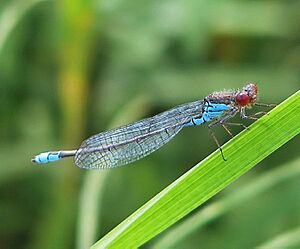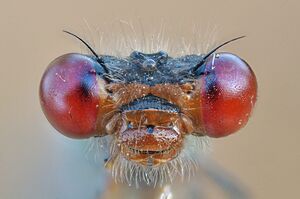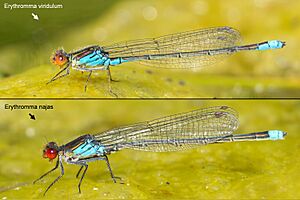Small red-eyed damselfly facts for kids
Quick facts for kids Small red-eyed damselfly |
|
|---|---|
 |
|
| Erythromma viridulum (male) | |
| Scientific classification |
The small red-eyed damselfly (Erythromma viridulum) is a type of damselfly. It belongs to the Coenagrionidae family. This damselfly looks very similar to its close relative, the red-eyed damselfly.
Contents
Appearance
This damselfly is quite small. It is about 29 millimeters (1.1 inches) long. Its body is mostly black with shiny blue markings. It has large, bright red eyes that are set far apart.
Both male and female small red-eyed damselflies do not have light spots behind their eyes. Their wing spots, called pterostigmata, are pale brown.
Male and Female Differences
The male damselfly has a bronze-black top. Its sides are blue. The female's chest area (thorax) can be yellow, green, or blue on the sides. The back edge of their neck area (pronotum) is rounded.
If you look at the male from the side, the second and eighth parts of its abdomen are mostly blue. This helps tell it apart from the red-eyed damselfly, where these parts are mostly black.
Reproduction
This damselfly likes to breed in calm waters. You can find them in ponds, lakes, and ditches. In some parts of Europe, they also live in slow-moving rivers. They can even live in slightly salty water.
They often live near floating plants. Some of these plants include Hornwort and Water Milfoil (Myriophyllum).
Laying Eggs
Female damselflies lay their eggs while connected to the male. They place the eggs into the stems and leaves of floating plants. The young damselflies, called larvae, live among pondweed. They usually emerge as adults after about one year.
Behavior
Mating happens either on floating plants or near the water's edge. When a male small red-eyed damselfly rests on a floating plant, it holds its abdomen slightly curved upwards. The red-eyed damselfly, however, holds its abdomen straight.
How It Spread to Britain
The number of small red-eyed damselflies in northwest Europe grew a lot in the late 1900s. In 1999, this species was seen in Britain for the first time. Since then, it has spread widely across Britain. It is now a regular breeding resident there.
The first time it was officially recorded in Britain was in Essex on July 17, 1999. Experts confirmed that they were breeding in Britain in 2002.



